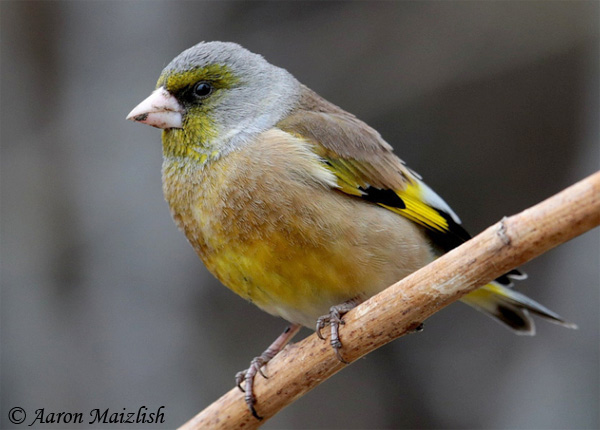| Length: 6 inches | Wingspan: 9.25 inches | Seasonality: Non-resident in South Dakota |
| ID Keys: Gray head with greenish face on males, brownish back, yellowish breast grading to tannish brown on belly, wings and tail black with yellow spots. Females similar but duller. | ||
 The
Oriental Greenfinch is well-named, with a normal range in eastern Asian that
extends from Kamchatka Peninsula of Russia in the northeast, southward
through Japan, North and South Korea, eastern and southern China, and
Vietnam. They are also sometimes called the Gray-capped Greenfinch. As
with some other passerines in far eastern Asia, they have been found as rare
vagrants in the far western Aleutian Islands. Elsewhere in North
America, there are confirmed sightings of Oriental Greenfinches in
California and in British Columbia in Canada. However, the source of
the birds found in North America outside of the Aleutian Islands and Bering
Sea may be questionable, with some sources considering these birds to be
likely escapees from captivity rather than true wild vagrants. The
likelihood of these birds being escapees is probably low, however, as there
are extremely few records of Oriental Greenfinches being kept by either
hobbyists, or by zoos and aviaries.
The
Oriental Greenfinch is well-named, with a normal range in eastern Asian that
extends from Kamchatka Peninsula of Russia in the northeast, southward
through Japan, North and South Korea, eastern and southern China, and
Vietnam. They are also sometimes called the Gray-capped Greenfinch. As
with some other passerines in far eastern Asia, they have been found as rare
vagrants in the far western Aleutian Islands. Elsewhere in North
America, there are confirmed sightings of Oriental Greenfinches in
California and in British Columbia in Canada. However, the source of
the birds found in North America outside of the Aleutian Islands and Bering
Sea may be questionable, with some sources considering these birds to be
likely escapees from captivity rather than true wild vagrants. The
likelihood of these birds being escapees is probably low, however, as there
are extremely few records of Oriental Greenfinches being kept by either
hobbyists, or by zoos and aviaries.
Habitat: During the summer breeding season, Oriental Greenfinches are most commonly found in coniferous to mixed coniferous/deciduous forests. A much wider variety of habitats are used in migration and during the winter months, as they may be found in forest edges and woodlands, riparian areas, shrublands and second-growth forest, and in suburban parks and gardens.
Diet: Feeds primarily on seeds and grains. They will also feed on insects, spiders, and other small invertebrates, particularly during the summer breeding season.
Behavior: Uses a variety of foraging techniques depending upon the food item, and may feed either on the ground, in shrubs or other low vegetation, or even high in a tree canopy.
Nesting: The nest is a cup of grasses and moss, lined with fine grasses and softer vegetation, placed in a tree or sometimes a bush. The female lays 2 to 5 eggs and she alone incubates them.
Song: The call of an Oriental Greenfinch is a distinct, nasal "djeeeeee"
Migration: Most Oriental Greenfinches are non-migratory. However, the sub-species that breeds in Kamchatka is migratory. This migratory sub-species is the one that is almost certainly the source of vagrant birds in North America.
Feeders: In their normal range, Oriental Greenfinches will attend feeders for a variety of offered seeds, suet, and nuts.
Interactive eBird map: Click here to access an interactive eBird map of Oriental Greenfinch sightings
Similar Species: Most similar to the European Greenfinch, a species that has not been found in North America. The Eurasian Siskin has similar plumage on the wings and tail, and is also a species that has been found on rare occasions as a vagrant on the western Aleutian islands. Of North American birds, Pine Siskins have similar patterns on the wings and tail, but plumage on the body is quite different and they are unlikely to be confused with Oriental Greenfinches.
Conservation Status: The Oriental Greenfinch is found across a very broad geographic range, is common in parts of its range, and the overall population is considered stable. The IUCN lists the Oriental Greenfinch as a species of "Least Concern".
Further Information: 1) WhatBird - Oriental Greenfinch
2) BirdLife International - Oriental Greenfinch
3) First Record of Oriental Greenfinch in Canada
Photo Information: Photo by Aaron Maizlish in Beijing, China - Photo licensed under Creative Commons Attribution Non-Commercial 2.0 Generic License
| Click below for a higher-resolution map |
|
|
| South Dakota Status: Non-resident in South Dakota |
Additional Oriental Greenfinch Photos (coming soon!!)
